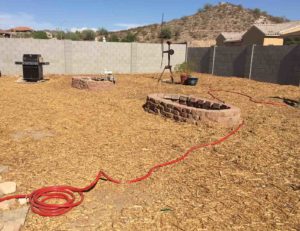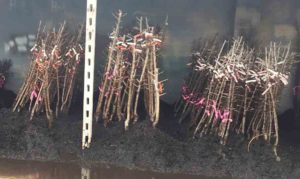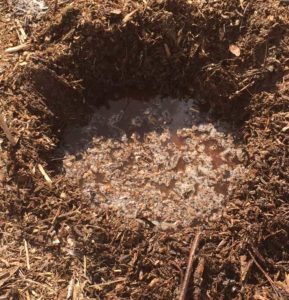The Fruit Tree Mud Bath Salon
Part one of: My journey to becoming an Urban Orchardist
By Janis Norton
(Read Part 2 HERE)
 I am going to be an Urban Farmer. In fact, not just an Urban Farmer—I am going to be an Urban Orchardist, too! Let me explain. I work for The Urban Farm and I help run the Urban Farm Fruit Tree Program, so how can I possibly not try to grow fruit trees in the yard of our new home? I mean, with the team of friends and mentors that I have, what could go wrong?
I am going to be an Urban Farmer. In fact, not just an Urban Farmer—I am going to be an Urban Orchardist, too! Let me explain. I work for The Urban Farm and I help run the Urban Farm Fruit Tree Program, so how can I possibly not try to grow fruit trees in the yard of our new home? I mean, with the team of friends and mentors that I have, what could go wrong?
I’ll start by telling you my husband is an amazingly patient man who just shook his head and sighed when I told him that we needed to dig at least a dozen holes in the dead, rocky, desert soil behind our home for the collection of deciduous fruit trees I had selected.
We knew we were going to have some challenges since our home was a new-build and had not really had any type of plant beyond a few weeds growing there since the heavy machines rolled across the entire area to flatten and compact the ground. We had deluded ourselves into thinking it could “not be that bad.” Anyway, I told myself it did not matter; I was determined to grow fruit trees, and to be honest I was a little naïve as to what was in store.
But with Greg’s encouragement and advice, we decided to take a year to observe and plan. It felt like the slowest year I have ever experienced. We started in the spring that we took ownership to prepare the soil. We covered our back yard in wood chips 4-8 inches thick, one wheelbarrow at a time. This was the talk of the new neighborhood as that huge pile of steaming mulch ever so slowly disappeared into the back. We saw a few days of rain here and there, so we loved that the wood chips did such a great job of retaining that water and not letting it run down the street.
Then later in the fall, we started digging the holes for the future orchard. I was excited and proud thinking I had prepared for the sun, the wind, the temperature, and good spacing between the trees. I was even planning on a permaculture-inspired guild of mid- and low-level plants to create the food forest of my dreams. In fact, after digging extra-large holes in what I thought was a sufficient attempt to give my new fruit trees some “wiggle room,” we re-filled the basins with wood chips to keep the holes prepped until I was ready with the trees in a few months. Let’s face it – wood chips worked for Jake Mace.
I waited a full four months until the ideal planting season. That was when I finally picked up my bare root trees from the Fruit Tree Program’s Pop-up Nursery in early February and had a weekend to plant them. I had several: peaches, apples, plums, a Pluerry, an apricot, and even a fig (to start with anyway). No citrus, but that is an entirely different story.
We removed the wood chips from the holes, and we planted a dozen bare root trees. Not realizing the rocky and clay soil also had a hard layer just about 6-8 inches below our dig, we proceeded forth to plant. We took care to prep the basins with good organic material and some amendments of worm castings, Azomite, and some mycorrhizae inoculate to help the roots succeed. If my trees had salivary glands, I was sure they would be drooling with anticipation.
However, despite all my months of observation, I was not aware of an impending issue because the wood chips were hiding a big drainage problem. In fact, we live in the Arizona desert and I was naively a little worried about getting water TO the trees, so my husband and I had thoughtfully dug some trenches so we could be prepared for irrigation pipes later. We were teasing each other, calling them our personal Hohokam canals in reference to local history of ancient water canals in the Sonoran Desert.
Then, when almost all of my trees were in, it rained. It rained heavy for about an hour, then light sprinkles off and on the rest of the day. This was a little heavy for our desert, but not unheard of by a long shot. We were ecstatic that the “canals” were going to help move water between the trees. We thought our trees would be loving the gift, and we delighted in planning how to keep the water in our yard. (Yes – this is what some people do in the desert.)
However, when we went out to look the next day, we had one hole still open and the ditches too, and we realized the water was not draining – AT ALL.
From previous tree planting training, I knew a percolation test should have good results in a few hours. Some helpful charts measure how many minutes it takes the water level to drop, and the slowest ratio they had was 1-inch-in-2-hours. My yard was so slow in draining it was off-the-chart!! I was staring at NO movement in 12 hours…perhaps half an inch in more than 36 hours, and that’s only IF I used an imaginary ruler that showed only 2-inch increments and I squinted.
This was bad. I basically had put my precious fruit trees in a very nutritious mud treatment worthy of a high-end salon. My poor trees were sitting in soup! So even if it was a great mud, I still knew they were going to drown.
Emergency action was called for! We ran down to the big box store to grab some extra-large planter buckets, and with some amazing help from a dear friend, we moved the trees into their temporary homes. Using a shovel was dangerous since I did not know where the roots were, so with a light dig and a gentle pull instead we could bring up the trees. To be honest, it was more like a slurping, sucking, sound from a sci-fi movie. The scary thing was that some of those trees were actually showing new root growth. They were ready for a permanent home and I had assaulted them in a growth moment.
I have never actually apologized to a plant before, but I was really hoping that they would not go into shock and I spoke to them at length explaining that I valued their health greatly and their forever homes needed an upgrade. I am sure my neighbors were a little concerned.
So at this point, I have an orchard with sad trees sitting in large pots and a war zone of holes. I need a new plan!
—
Part Two – Becoming a Fruit Tree Slum Lord.
 Janis is a graduate of the Arizona State University, School of Sustainability, earning her BS in Sustainability. And although she had a strong focus to find opportunities to help educate and strengthen her communities in sustainability methods, she did not realize how much she could do with the local food system until her Sustainable Food and Farms class. All previous misconceptions of having a black thumb were no longer obstacles. She became motivated to learn all she could about gardening and urban farming.
Janis is a graduate of the Arizona State University, School of Sustainability, earning her BS in Sustainability. And although she had a strong focus to find opportunities to help educate and strengthen her communities in sustainability methods, she did not realize how much she could do with the local food system until her Sustainable Food and Farms class. All previous misconceptions of having a black thumb were no longer obstacles. She became motivated to learn all she could about gardening and urban farming.
Then she found an opportunity to use her organization and project management skills to help facilitate a couple of the Urban Farm larger events. From that point on, she has been an active part of the Urban Farm team. She is bringing her enthusiasm and cheerful attitude to her projects at the Farm especially the Annual Fruit Tree Program and the Urban Farm Podcast, as well as the Great American Seed-Up which is a partner project with GrowPhx.













I am so excited to read about your adventures here, because my yard has the very same problem! I look forward to learning from your experience!
This is a well-written article with enough humor for me to anticipate what you did next. Ooooo…cliff hanger…